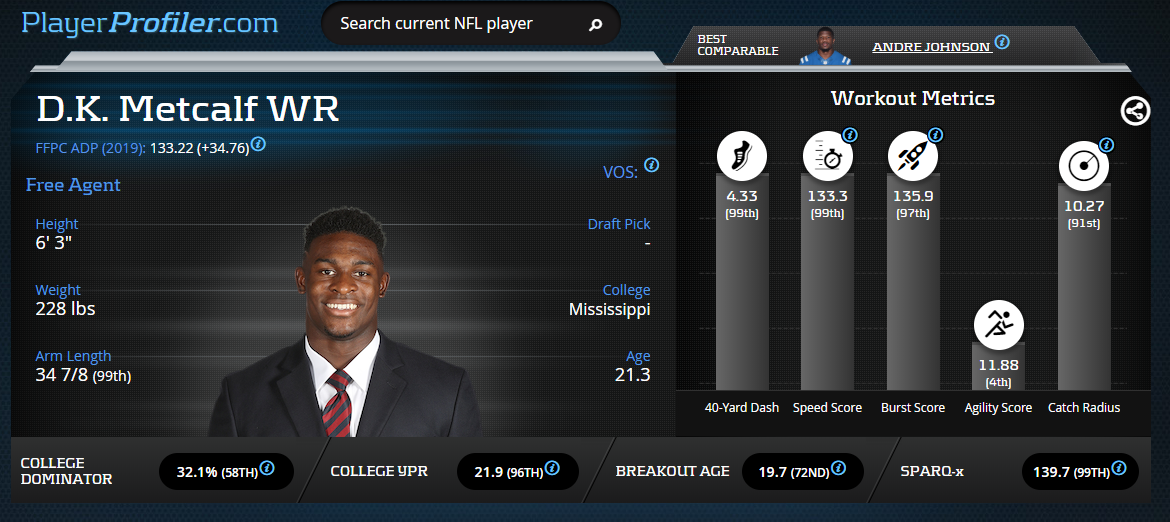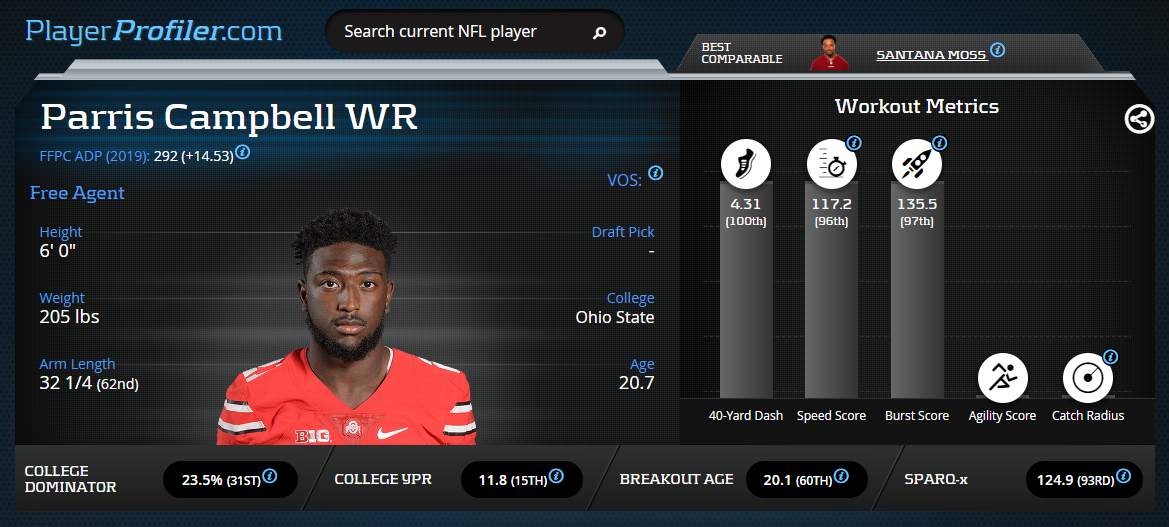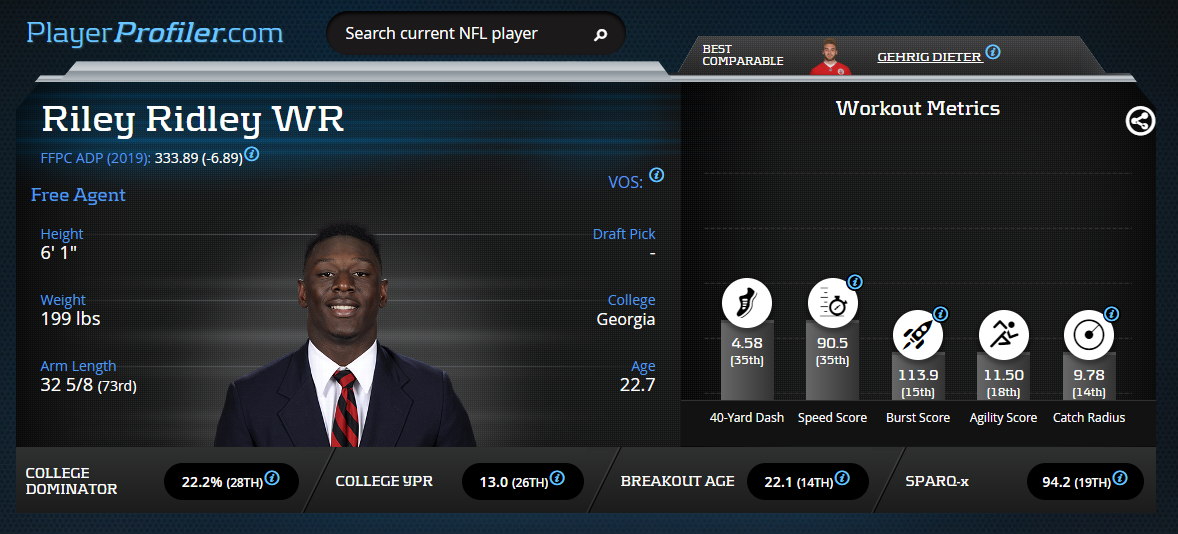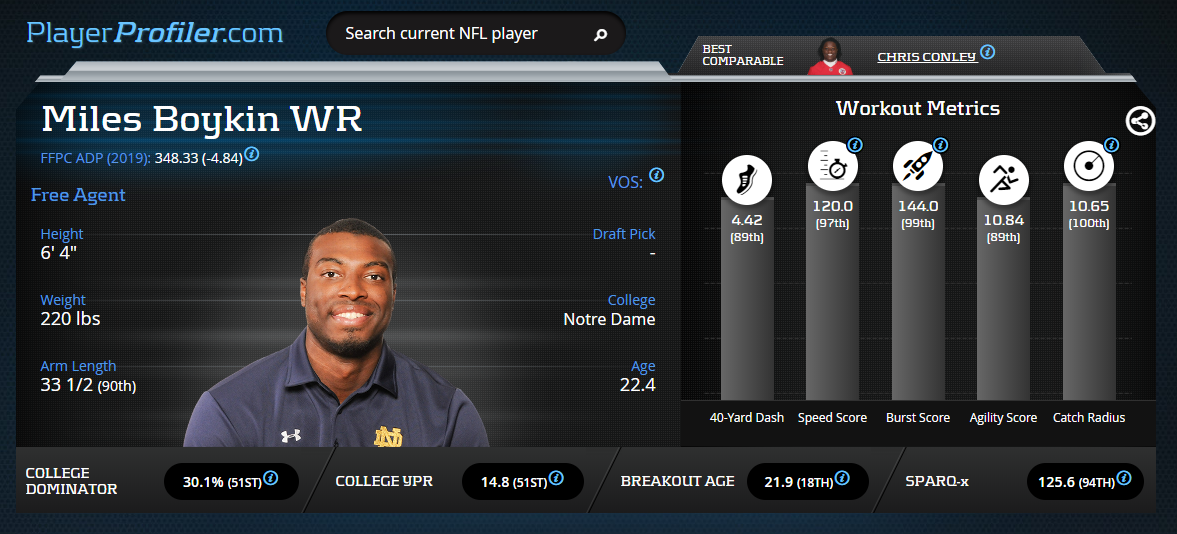The single most overrated day of the NFL offseason is the NFL Scouting Combine. For an extended weekend, the nation’s brightest young stars, and sometimes the third-stringers who went to prestigious schools, attend an extended workout where they get to prove if they’re fast, explosive, agile, and strong. Every year, deserving small school players get snubbed, but that’s beside the point. Generally speaking, an invite to the NFL Combine is a good sign for a player’s NFL career arc, as Combine attendees have more success and more longevity than those who don’t receive an invitation. Naturally, the true cause is most likely that these are most of the premium prospects and athletes, but hey, all we really need to know is that the Combine invitation is a good sign. Most years, there is a wide range of outcomes, with some players testing off the charts across the board (Saquon Barkley, George Kittle) and some players face-planting (Antonio Brown). Some players opt not to test in particular drills (Lamar Jackson, 40-yard dash) as well. Inevitably, nearly everyone over-reacts to the standout performances, especially when they are not accompanied by strong college production (which both Barkley and Kittle had, of course). We know that athleticism is important for running backs, but does it matter as much for wide receivers, especially if there are questions with their production profile? Unless you live under a rock, you know that the receiver most in question is D.K. Metcalf, who shredded the NFL Combine (except for the agility drills), but didn’t quite dominate at Ole Miss (perhaps due to the fact that he played with A.J. Brown and DaMarkus Lodge, but perhaps not).
To figure out if athleticism without college dominance matters, I looked at every rookie prospect and veteran wide receiver in the PlayerProfiler database who had Athleticism Score and a SPARQ-x Score (to ensure they had adequate speed, burst, and agility metrics), as well as a College Dominator. That’s over 700 veterans and almost 100 rookie prospects. I combined their athleticism metrics and compared against the group to get essentially a percentile rank of their athleticism metrics all combined into one, and did the same with College Dominator. By exploring the greatest differences between athleticism “rank” and College Dominator Rating “rank” I identified wide receivers whose athleticism vastly outranks their college production. Of the veterans, the nicest way I can put this is that most of the top players on my list had “unsuccessful” NFL careers as wide receivers.
I have heard of a lot of fringe NFL players, and six of the top ten do not fall in that category. Number two on the list is Devin Hester, who didn’t exactly have success as a wide receiver, so he doesn’t count as a success for this purpose. Greg Little checks in at number three, and made it through his rookie contract with the Browns… barely. He topped out at 61 receptions and 709 yards in his rookie season and never scored more than four touchdowns, though he was propelled to being a second-round draft pick by his athleticism and copious speculation. Robert Foster (who has about half of a decent season, and whose college numbers are depressed due to injury) is the only other player of note in the top 25 players on this list. Inside the top 50, we finally see success in the form of Chris Hogan (though his College Dominator Rating was depressed since he only played one year of college football, and played QB, WR, and DB all at the same time) and Marquise Goodwin. Even so, Hogan has never topped 50 yards/game in a given season, and Goodwin has a single season with 56 catches for 962 yards, but he only scored two touchdowns that year and has never topped 30 catches or 450 yards in another season. The last names of any relevance inside the top 50 players are Andrew Hawkins, Deonte Thompson, and Cordarrelle Patterson (like Hester, not successful as a wide receiver). So basically, it’s not pretty.
https://www.youtube.com/watch?v=FzkUcrGVj30
Now for the caveat: my list of veterans skews towards very weak college production more than elite athleticism. Only two players mentioned above (Hogan and Patterson) have over a 15% College Dominator. The composite athleticism scores by my calculations for every player came in over the 75th-percentile, for what it’s worth. However, even the top 50 list of players with a 15% or higher College Dominator (including Hogan and Patterson) includes few names of any relevance, though. Tyreek Hill, who breaks all models and logic, Martavis Bryant, who may have been much more successful but for off-field issues, and Travis Benjamin, who never ascended to a reliable fantasy producer, are the only three players with any real success on the list. The key point here is that athleticism with weak college production tends not to produce reliable fantasy football assets (or even reliable NFL players). So, where do we stand with the 2019 rookie class? There are several names whose athleticism far outranks their production profile (measured the same way as the veterans). Looking only at players of interest, some names stand out.
Big Names
D.K. Metcalf, Mississippi
D.K. Metcalf leaves Ole Miss after two “real” seasons (he played just two games in his true freshman year). Metcalf’s best season by counting statistics is his 2017 campaign featuring 39 receptions for 646 yards and 7 scores. However, in his 2018 season, he played just seven games, so his 26 receptions for 569 yards (a massive 21.9 yards per catch) and five touchdowns really marks his best year as a Rebel.
Check out Davante Adams on PlayerProfiler’s Dynasty Rankings:
Due to his missed time, Metcalf’s lukewarm counting statistics still result in a solid 32.1-percent (58th-percentile) College Dominator Rating, which is much more impressive in the context of playing with teammates A.J. Brown and DaMarkus Lodge, who were also both invited to the NFL Combine, and are likely to be drafted this year, with Brown expected to go early as well. Metcalf’s 21.9 (96th-percentile) yards per reception is an eye-popping number for a full-time player, and his already-impressive 19.7 (72nd-percentile) Breakout Age would likely have been even better if he wasn’t shut down after two games in 2016 due to a foot injury.
On the athleticism side of the ledger, Metcalf’s mind-bending athleticism, and his profile looks pretty strong. Metcalf posted a 133.3 (99th-percentile) Speed Score with a 4.33 second (99th-percentile) 40-yard dash at 6’3″ and 228-pounds, which is nearly incomprehensible. He followed that up with a 135.9 (97th-percentile) Burst Score, but then bombed the agility drills and recorded just an 11.88 (4th-percentile) Agility Score. Metcalf will be – and should be – a very early first-round rookie pick, but the word of caution here is just not to take him ahead of N’Keal Harry, who is marginally less athletic (pending Agility Score) but was more dominant at the college level and at a younger age. Harry is a complete prospect with holes to his profile unless he tests in agility drills and also flops. There is also a compelling case to be made for A.J. Brown over D.K. Metcalf. So, at least for now, don’t let Metcalf’s athleticism suck you into him at 1.01.
Parris Campbell, Ohio State
Despite staying in college for all four years, Parris Campbell showed marked improvement each season, topping it off with 1,063 yards and 12 touchdowns in his senior season on 90 receptions. Campbell then exploded at the NFL Combine, recording a 117.2 (96th-percentile) Speed Score and a 135.5 (97th-percentile) Burst Score, while opting out of the agility drills. At 6’0″ and 205-pounds, Campbell’s size offers him some versatility at the NFL level, and his athleticism (if he’s agile as well), would fully support that.
Campbell recorded 14.6 yards per reception in his junior season, and just 11.8 in his final year at Ohio State, indicating that he is unlikely to be a deep ball threat at the next level, despite a 4.31-second (100th-percentile) 40-yard dash. Campbell, unfortunately, looks like he may best be used as a gadget player (a la Tavon Austin or former teammate Curtis Samuel, now of the Carolina Panthers). Campbell’s 23.5% (31st-percentile) College Dominator is not inspiring, but his 20.1 (6oth-percentile) Breakout Age is impressive considering that Ohio State often boasts other strong players that would have crowded Campbell out. Campbell was competing with fellow NFL-hopefuls Terry McLaurin and Johnnie Dixon for his whole career, as well as second-round pick Samuel and seventh-round pick Noah Brown in 2016 and second-round pick Michael Thomas in 2015.
https://www.youtube.com/watch?v=2psJwkz2jbk
Campbell’s profile certainly has some red flags, but his upside is undoubtedly there, especially if his speed translates to deep targets at the next level. Campbell should be viewed with caution in the first round when in the company of the top wideouts (N’Keal Harry, A.J. Brown, D.K. Metcalf) but enters autopick territory in the second round courtesy of his teammate quality factor, because the upside is tantalizing.
Riley Ridley, Georgia
Despite testing under the 20th-percentile in Burst Score and Agility Score and 35th-percentile in Speed, Ridley’s athleticism (or lack thereof) still well outpaces his college production relative to the rest of the rookie wideouts. Ridley, like his brother Calvin, is coming out of college as a junior, which is a good sign, but unlike Calvin, one time thought to be the most overrated wide receiver in last year’s rookie class, Riley never even dominated at the college level. After failing to reach even 250 yards in his first two seasons (with competition such as seventh-round pick Javon Wims), Ridley accrued just 559 yards and nine touchdowns on 43 receptions in his 14-game junior season as the “featured” weapon.
Ridley’s already-poor 22.2-percent (28th-percentile) College Dominator Rating is even worse considering it was buoyed by touchdowns and not copious targets and yards. Even worse is Ridley’s age — he’s currently almost 23 years old and his Breakout Age is 22.1 (14th-percentile), well below brother Calvin, who at least performed adequately against far younger competition. So, Ridley amounts to an old, unathletic wide receiver who never dominated at the college level. He doesn’t even really fit the mold of this article, but he is the single biggest booby trap in this year’s rookie class and should be avoided like the plague.
Miles Boykin, Notre Dame
Boykin tested through the roof athletically, posting a 120.0 (97th-percentile) Speed Score, a 144.0 (99th-percentile) Burst Score, and a 10.84 (89th-percentile) Agility Score. On top of that, Boykin performed decently in his senior season at Notre Dame, totaling 59 receptions for 872 yards and eight scores in 13 games, good for a 30.1% (51st-percentile) College Dominator, a respectable mark at a big-time program. The major downside with Boykin is that he did not make a splash until his senior season, leading to a 21.9 (18th-percentile) Breakout Age. Boykin didn’t break out until after a wide receiver would ideally have entered the NFL Draft (age-wise).
Boykin’s major red flag is the Breakout Age and the fact that he’s essentially 22-and-a-half years old already. His high-end athleticism and reasonable college performance at a late age make him best comparable to Chris Conley, who still face-planted despite being given a golden opportunity last season with Patrick Mahomes and company running the offense in Kansas City. A late Breakout Age generally indicates that players are near their peak, whereas the early breakout players who come out early (e.g., N’Keal Harry) can be as good if not better out of the gate, and still have more room to grow (e.g., JuJu Smith-Schuster vs. Cooper Kupp). Approach Boykin’s athleticism with caution, though he at least has one season of solid production, so he is not a complete fade. The third round or later is a fine place to start considering Boykin.
Under-The-Radar
Terry McLaurin, Ohio State
Terry McLaurin stands at 6-0 and 208-pounds, so he has nice size for a versatile NFL wideout. He tested well across the board athletically, posting a 114.6 (94th-percentile) Speed Score, a 126.3 (76th-percentile) Burst Score, and an 11.16 (57th-percentile) Agility Score. McLaurin’s testing results give him what amounts to a 126.2 (94th-percentile) SPARQ-X score. After recording just 11 receptions in his sophomore season through 13 games, McLaurin finally made some noise as a junior with 29 catches for 436 yards and six touchdowns, which is still underwhelming. McLaurin had to return for his senior season, which alone is an indictment, and he posted 35 catches for 701 yards and 11 touchdowns, so McLaurin’s 17.7% (18th-percentile) College Dominator was buoyed by touchdown scoring. The only potential saving grace for McLaurin is that he was overshadowed by other talented WRs at Ohio State including the aforementioned Parris Campbell and subsequently-mentioned Johnnie Dixon. That said, McLaurin’s low College Dominator is a near death sentence for becoming a fantasy asset, so look elsewhere with your late-round picks.
Johnnie Dixon, Ohio State
Like teammate Terry McLaurin, Johnnie Dixon was a fifth-year senior, so we’re already starting in a bad place. His first meaningful impact was as a junior when he posted just 18 catches for 422 yards (an impressive 23.4 per catch) and eight touchdowns. Like McLaurin as well, he underwhelmed until his senior season, when he racked up 42 catches for 669 yards and eight scores. Dixon’s College Dominator comes out even worse than McLaurin’s (similar yardage but fewer touchdowns) at 15.8% (14-percentile). Dixon’s athleticism is also more disappointing, as he posted a 101.9 (73rd-percentile) Speed Score, a 123.8 (65th-percentile) Burst Score, and opted out of the agility drills. Dixon’s lack of results in the agility drills is concerning given that he stands at 5’10” and 201-pounds, as that would be his most likely place to shine. Dixon’s one redeeming factor is his 19.7 (92nd-percentile) yards per reception mark when combining his senior and junior seasons. Dixon may carve out a deep threat role if anything, but his outlook is bleak, and I’d certainly even rather have McLaurin between the two. Dixon is a hard pass in the later rounds of rookie drafts.
Olabisi Johnson, Colorado State
Olabisi Johnson‘s best season was his senior year, and he still managed just 54 catches for 796 yards and four touchdowns, which gives him a 20.3% (24th-percentile) College Dominator. Since he played at a smaller school, that’s all you really need to know in order to fade Johnson with your later-round rookie picks. However, it gets worse. Despite posting athleticism above the 50th-percentile across the board, Johnson was not able to dominate CSU’s competition until his senior season (and even then, just barely). Johnson is now 22 years old, and his Breakout Age is 21.5 (26th-percentile). If athletic players at small schools can’t break out at a young age, there is essentially no chance of them having NFL success. Since Johnson doesn’t have the slight doubt about his teammates overshadowing him, he’s the hardest pass on the list.







